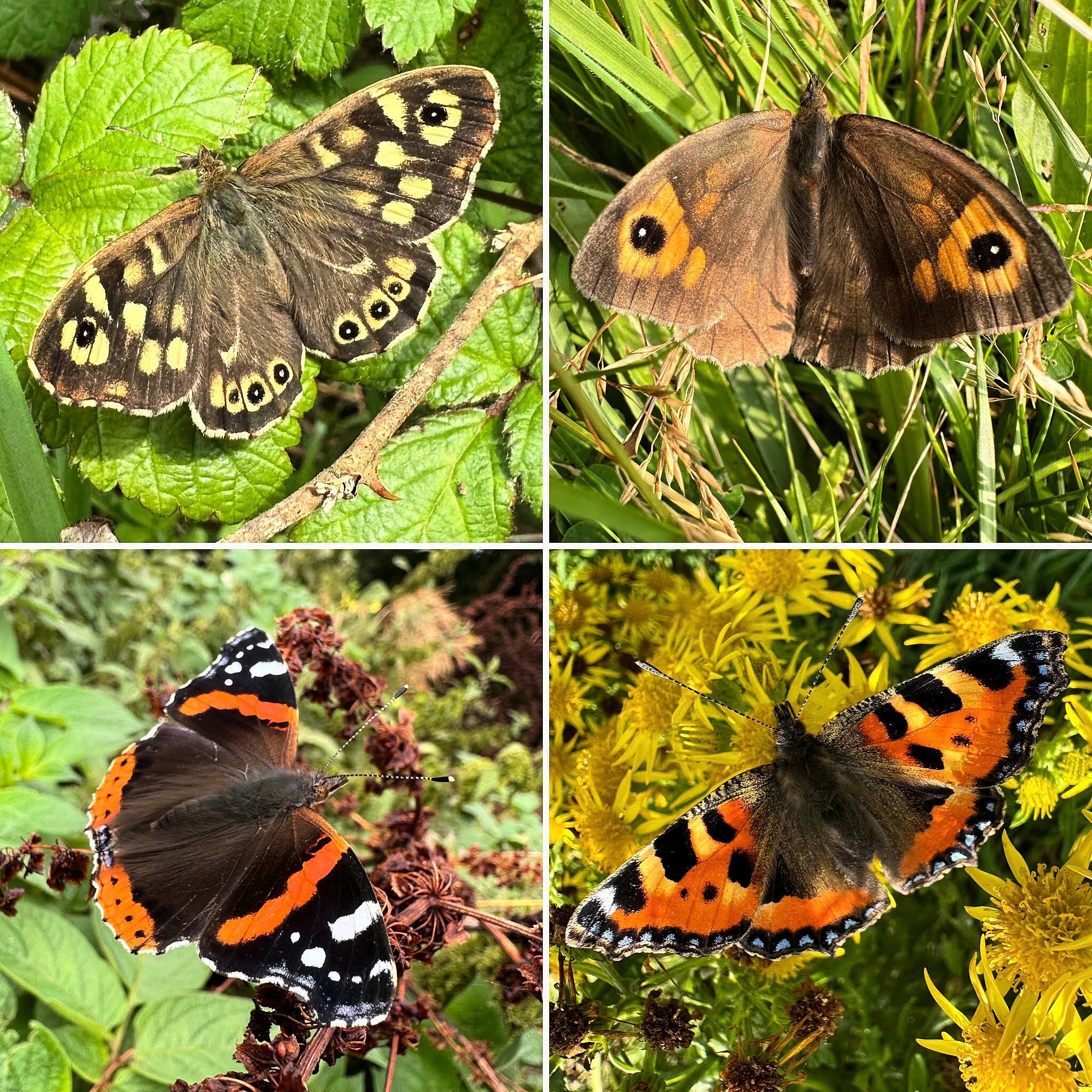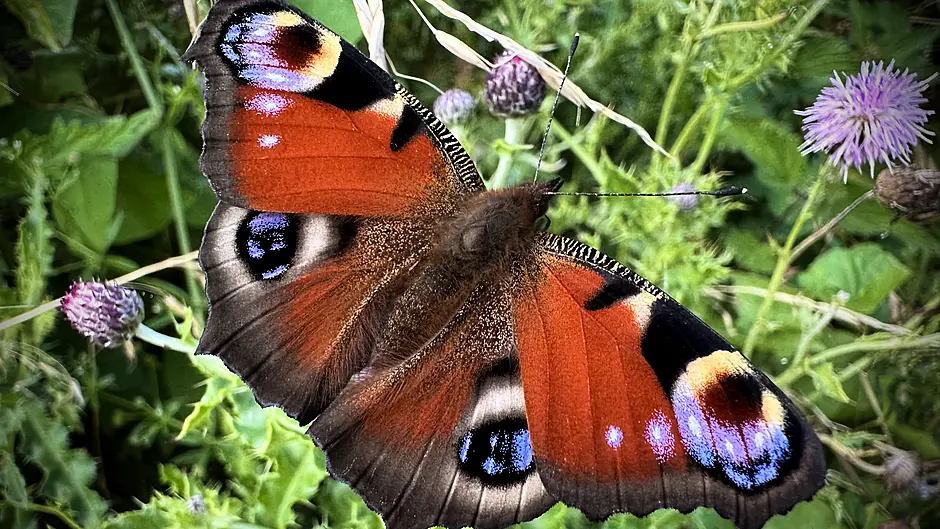
Summer seems to have crept up quickly, and we are already at its height, making it the perfect time for spotting butterflies.
Out on An Móin Rua, or Toe Head, we have seen plenty of painted ladies making landfall after their incredible journey from as far away as sub-Saharan Africa.
Along the hedgerows, meadow browns flit through the countryside.
Even in Skibbereen playground, while the boys played football, we spotted ringlet butterflies drifting through the pollinator-friendly areas.
Forty butterfly species have been recorded in Ireland, with 32 of those being resident year-round.
This week, let’s look at the top five butterfly species you’re most likely to spot in West Cork, learn what makes them special, and discuss why they are disappearing.
Speckled wood
The speckled wood is one of Ireland’s most common butterflies and is frequently seen in West Cork, especially in woodland and hedgerows. Their deep brown wings are marked with creamy spots. A highly territorial species, they are often seen tumbling and spiralling mid-air in skirmishes with intruding butterflies. When not defending their patch, they often bask in sunny clearings.
A long flying season, typically from late February to early November, gives ample opportunity to spot the speckled wood. Unusually, they prefer to feed on honeydew rather than nectar. Honeydew is a sugary substance secreted by aphids as they feed on plants.
Speckled woods usually forage high in the tree canopy where honeydew coats the leaves and branches, descending in spring and autumn when supplies are low. This feeding behaviour highlights the delicate web of nature’s interdependence, where a decline in aphids could negatively affect butterfly populations.
Meadow brown
The meadow brown is widespread in Ireland and flies from June through to August. Like the speckled wood, they are a resident species, with caterpillars that feed on a variety of grasses. While still common, their population has declined by 77% since 2008, according to the Irish Butterfly Monitoring Scheme by the National Biodiversity Data Centre.
This decline is mainly due to habitat loss., with fewer meadows for the meadow brown. Meadows and semi-natural grasslands have been ploughed, grazed, seeded, and intensively managed, reducing safe breeding grounds and the diversity of native plants and grasses. Nevertheless, meadow browns can still be seen along hedgerows foraging for nectar. Creeping thistle is one of their favourite flowers, so watch thistle-rich patches closely.
Red admiral
Red admirals are among our larger butterflies, making them hard to miss. A migratory species, they arrive in spring and summer from Southern Europe and North Africa. They come specifically for our nettles, where they lay their eggs for their caterpillars to feed. For this reason, it is important not to remove all nettles. Most of the red admirals that hatch and develop here migrate back south before winter. It is astonishing to think of these delicate creatures flying such long distances across land and sea.
 Clockwise from top left: the speckled wood, meadow brown, small tortoiseshell , and red admiral butterflies.
Clockwise from top left: the speckled wood, meadow brown, small tortoiseshell , and red admiral butterflies.
Small tortoiseshell
A year-round resident, the small tortoiseshell overwinters as an adult and emerges in spring and summer to also lay eggs on nettles. They are the species most found inside houses during winter, often emerging confused when the heating comes on, having entered in late summer to hibernate.
Simply releasing them outdoors in winter is likely to be fatal. Instead, move them to an unheated room or shed, or place them in a lidded, ventilated, kitchen roll-lined container in the salad drawer of the fridge until it warms up outside.
Peacock
The peacock butterfly is one of our most striking species. Their rusty-red wings are each marked with a bold eyespot, ringed in blue, yellow, and black. These eyespots resemble those on a peacock’s feathers and help startle predators such as birds.
I once read something about the peacock butterfly that I now can’t unsee: if you view their wings upside down, the hind wings and body resemble an owl’s face. Try turning your Southern Star 180° and have a look.
Butterfly decline
It is depressing to hear the same news year after year, but unfortunately, the summary from last year’s butterfly season is again that butterflies are declining. The latest results of the Irish Butterfly Monitoring Scheme show that the overall trend across 15 of the commonest butterfly species is a decrease of 66% compared to 2008. No species shows an increase in population size.
This decline is caused by multiple factors: fertiliser use, loss of semi-natural grassland, pesticide application, urbanisation, planting of non-native trees on previously open land, and climate change.
What you can do
In the face of such loss, many wonder how they can help. The good news is that even a small garden, managed thoughtfully, can support butterflies. The website pollinators.ie offers practical guidance on growing nectar-rich flowers for butterflies to feed from, foodplants to support caterpillars, and how to create a mini wildflower meadow instead of a lawn.
Avoiding herbicides and pesticides is crucial for butterfly conservation. Less obvious actions include collecting rainwater in water butts and watering plants during dry spells, as flowers produce less nectar in drought conditions. It’s also important to avoid compost that contains peat. Peatlands are vital long-term carbon stores, and harvesting peat releases stored carbon, contributing to climate change which harms butterflies and biodiversity. You can also volunteer to take part in monitoring butterflies. Data on their population numbers is proving critical to motivate appropriate conservation actions.
Butterflies are magical and a delight for all ages. Their ongoing decline makes it more important than ever to appreciate them and take action.
We must not allow their final magic to be a disappearing act.








